
(1) Large incense burner created in the shape of a winter melon
by Murakami Moriyuki; around 1906;
held in the
collection of Kiyomizu Sannenzaka Museum
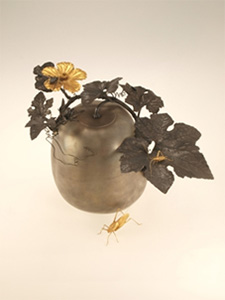
(2)Dragon figures with movable bodies and limbs
by Akiyama Chikurinsai; Taisho period to early Showa period;
held in the collection of Kiyomizu Sannenzaka Museum
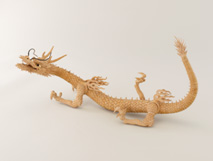
(Reference)White dragon figure
by Akiyama Chikurinsai
Held in the collection of
the Osaka Museum of History
(donated by Saijo Toshihiro)
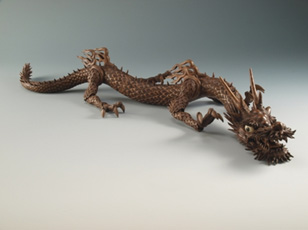
Born in 1889, Akiyama Chikurinsai was a wood sculptor active in Kohama, Osaka. While he also made ordinary decorative figures and Buddhist statues, his unparalleled craftsmanship is best demonstrated by his wooden dragon figures with movable bodies and limbs. Realistically shaped animal figures with articulated, movable bodies and limbs are called jizai okimono in Japanese. While most jizai okimono are made from metal, Chikurinsai’s works are made from wood, and thus are quite unusual. The process of making these wooden dragon figures was very time- and energy-consuming: they were so elaborately designed that Chikurinsai could make only few works in his lifetime, as he himself wrote that he spent two years completing one dragon figure. Chikurinsai’s dragon figures are roughly divided into two types: colored “black dragons” and non-colored “white dragons” as shown in the photos. This exhibition shows both types of dragons for the first time.
(3) Sword bearing the inscription
“Made in November 1898 by Gassan Teiichi,
artist and member of the Osaka
Branch of the Japan Art Association,
upon request of the Osaka Branch of the Japan Art Association”;
1898;
held in the collection of the Tokyo National Museum;photo courtesy of TNM Image Archives


Gassan Teiichi I, born in 1836, was an Osaka-based master swordsmith, who was appointed as an Imperial Household Artist later in his life. This sword was made upon request of the Osaka Branch of the Japan Art Association as a tribute offered to the Emperor Meiji on his visit to Osaka for large-scale maneuvers of the Imperial Japanese Army. All the components of the sword―the clear surface steel, the beautiful shimmering pattern of shiny crystals along the cutting edge, and the sophisticated engraving―are finished to the highest quality. This sword was presented to the Emperor Meiji by Sano Tsunetami, the president of the Japan Art Association at the time.
(4) Hannera-like tea container
by Miyoshi Mokusho (Yajihei);early Showa period;
held in the collection of the
Itsuo Art Museum(Hankyu Culture Foundation)
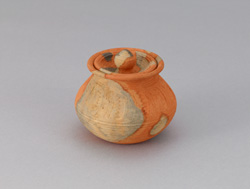
Miyoshi Mokusho was born in 1874 and was the son of a furniture maker in Osaka. He excelled not only in furniture making skills but also in lacquering, and was good at creating wooden articles with metal or ceramic texture using an unorthodox lacquering technique. A hannera is an earthenware pot made in Southeast Asia, popular among Japanese as a tea ceremony utensil. Though this particular work looks exactly like an earthenware pot, in reality, it is made of wood. With amazing craftsmanship skills, Mokusho gave it an earthenware texture just by using the furniture-making technique of shaving wood very thin and applying colors on it.
(5) Wagtail
by Yamamoto Kyoen (being shown to the public for the first time);1901;
held in the collection of the
Osaka Museum of History(donated by Morita Kazuko)
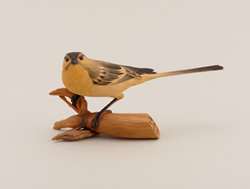
Yamamoto Kyoen was born in 1869 in Osaka and was the grandson of Morikawa Toen, a renowned sculptor of Nara, and trained as a sculptor under the grandfather, Toen, and his uncle, Morikawa Kyoen. However, his works and profile have been totally unknown to the public until today. This work was owned by the descendants of Yabu Meizan, an artist who started a workshop of Satsuma-style pottery in Osaka, and donated to the Osaka Museum of History together with works of Meizan. This colored wooden sculpture of a wagtail, which is of superb quality and so cute, is being shown to the public for the first time.

Murakami Moriyuki was born in Hagi in 1846. He moved to Tokyo in 1868 and was apprenticed to Unno Moritoshi, a metalsmith who had inherited the technique of making sword fittings. In 1893, Moriyuki moved to Osaka and lived near Shoen-ji, an ancient temple located in Tengachaya, where he engaged in making craft products. The flower and insects on this incense burner, which seem so real, were made by combining metal pieces of different colors and applying the chasing technique. Definitely, this is one of his best works.